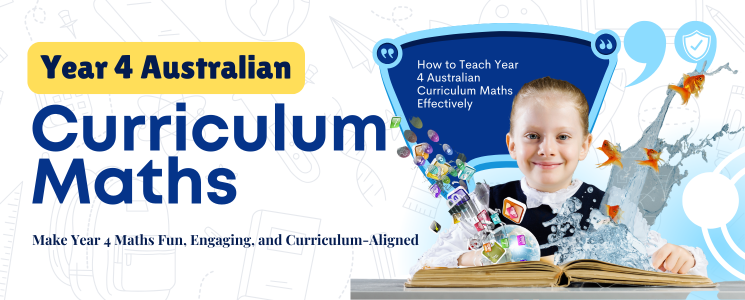Teaching mathematics through the Australian Curriculum Maths framework is more than solving equations or memorizing formulas. It is about helping students understand the why behind every concept. The goal is not only to teach calculations but also to nurture logical thinking, problem-solving, and confidence in applying maths to real life.
For teachers, following this framework means designing lessons that combine structure and creativity. It encourages exploration and ensures that every student develops essential mathematical skills step by step.
Understanding the Australian Curriculum Maths Framework
The Australian Curriculum Maths is designed around three core dimensions: understanding, fluency, and reasoning. Together, these guide how teachers plan, teach, and assess their lessons.
Why These Three Dimensions Matter
Each of these pillars shapes a different aspect of mathematical learning:
- Understanding allows students to grasp how and why mathematical ideas work.
- Fluency helps them perform calculations with accuracy and speed.
- Reasoning strengthens their ability to explain, justify, and connect ideas.
When a teacher balances all three, students gain not only competence but also confidence. They learn to approach challenges logically, which is the heart of mathematical literacy.
Making Maths Meaningful in the Classroom
One of the most effective ways to engage students is by making maths relatable. Many learners struggle because they cannot see how the subject fits into their lives. The Australian Curriculum Maths framework encourages teachers to use real-world examples that help students connect numbers to daily experiences.
You might show how geometry applies in architecture or how percentages are used in shopping discounts. When students see these links, abstract ideas suddenly make sense.
Practical Tips for Teachers
- Use examples from everyday life, such as cooking, travel, or budgeting.
- Incorporate storytelling or problem scenarios that make lessons memorable.
- Encourage group discussions so students can share different problem-solving approaches.
This approach not only improves comprehension but also builds curiosity. Students start to ask questions and explore concepts beyond the textbook.
Building Confidence and Fluency
Fluency in maths does not come overnight. It develops through consistent practice, feedback, and reflection. However, fluency does not mean memorizing procedures without understanding. It means being flexible and accurate in applying what one has learned.
The Australian Curriculum Maths emphasizes practice with purpose. Teachers should include varied exercises that test understanding, not just speed.
Encouraging Mathematical Thinking
- Allow students to solve problems in different ways.
- Ask them to explain their reasoning before sharing the correct answer.
- Praise effort and logical thinking, not just right answers.
When students understand that making mistakes is part of the process, they become more open to learning. Over time, this builds resilience and self-assurance in tackling complex problems.
Integrating Problem-Solving into Lessons
Problem-solving is at the center of effective maths teaching. It turns theoretical learning into practical application. Under the Australian Curriculum Maths framework, teachers are encouraged to give students problems that challenge them to think creatively and critically.
You can design activities where learners calculate costs for a school event, plan travel itineraries using time and distance, or analyze data trends from real-life situations. These examples make learning enjoyable and show students how maths exists everywhere.
The Power of Collaborative Learning
Group activities can make a huge difference. When students work together, they learn to communicate mathematical ideas, respect different viewpoints, and build on each other’s strengths. Collaboration mirrors real world problem-solving, where teamwork often leads to better solutions.
Creating a Positive Environment for Learning
Mathematics anxiety is common, but the right environment can eliminate fear. Teachers play a vital role in shaping students’ attitudes. By creating a supportive classroom, students feel safe to participate, ask questions, and learn from their mistakes.
The Australian Curriculum Maths promotes inclusivity. It allows teachers to adapt lessons for varied learning abilities, ensuring every child progresses at their own pace.
Encouraging a growth mindset, where effort is valued over immediate success, helps students build confidence and persistence.
Ways to Build a Supportive Classroom
- Celebrate small wins to motivate consistent effort.
- Provide gentle, constructive feedback.
- Encourage peer learning by pairing students with different skill levels.
- Maintain open communication to identify learning challenges early.
A positive environment does more than reduce anxiety; it nurtures long-term appreciation for the subject.
Planning Lessons That Align with Curriculum Goals
Planning is the foundation of successful teaching. Each lesson must align with the learning outcomes of the Australian Curriculum Maths framework. This ensures that progress is structured and measurable across grade levels.
Good planning means understanding how each concept builds upon the previous one. Before teaching multiplication, for instance, students should have a solid grasp of addition and grouping.
Teachers can also use formative assessments to adjust lessons. If a student struggles with a topic, the plan can be modified to include extra practice or visual support.
Effective Planning Tips
- Begin with clear, curriculum-linked objectives.
- Include different teaching methods, visual, verbal, and practical.
- Reinforce earlier concepts regularly.
- Track progress using short assessments or observation.
A well-organized plan gives both teachers and students clarity, ensuring that learning stays on course.
Using Assessments to Strengthen Learning
Assessments are not just tools for grading; they guide growth. The Australian Curriculum Maths encourages ongoing assessment that helps teachers understand where students stand and what support they need next.
Formative assessments, such as quick quizzes, class discussions, or student reflections, can provide real-time insight into learning progress. Summative assessments, such as unit tests, measure overall achievement.
Balancing Assessment with Feedback
Good feedback focuses on effort and improvement. It helps students recognize their strengths and identify specific areas to work on. When assessment becomes a partnership between teacher and student, it transforms from a judgment tool into a motivational one.
Encouraging Lifelong Mathematical Curiosity
The Australian Curriculum Maths aims to inspire students to see maths as more than a school subject. It is a way of thinking that encourages curiosity, precision, and problem-solving.
When students understand how math influences daily life, budgeting, technology, design, and science, they start appreciating its importance. Teachers who make math engaging create learners who carry these skills into adulthood.
Cultivating a Growth Mindset
A growth mindset helps students understand that ability in maths is developed through practice, not fixed talent. Teachers can encourage this by:
- Highlighting real-world benefits of mathematical skills.
- Emphasizing the process of learning, not just results.
- Showing enthusiasm and passion for the subject.
When curiosity replaces fear, learning becomes natural and enjoyable.
Teaching Maths the Smart Way
Teaching according to the Australian Curriculum Maths standards means more than following a set of guidelines. It is about empowering students to think critically, apply knowledge creatively, and see mathematics as part of their lives.
By balancing understanding, fluency, and reasoning, teachers can turn maths into a subject that excites rather than intimidates. With real-world connections, thoughtful planning, and a supportive classroom, every learner can build a lasting relationship with mathematics.
Great maths teaching goes beyond numbers, it shapes confident, capable thinkers ready to succeed in a complex world.







